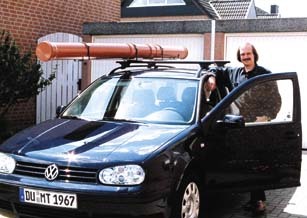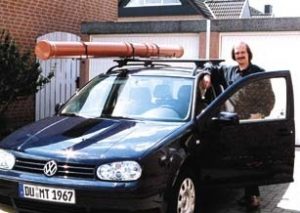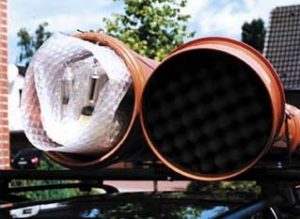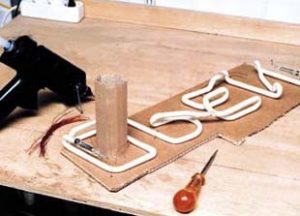Having visited many glass shops over the years, I’ve often heard shop employees shout, "Don’t break the neon," to installers and parcel-service drivers handling custom-made neon tubes. Transporting bent, glass tubes without breaking them requires careful handling. Improper packing and crating, as well as atypical transport environments, account for more than 80% of neon-tube breakage. This month’s article focuses on how to safely and effectively transport neon tubes.
In certain applications, glass is as flexible as stainless steel. In terms of compression forces, glass can withstand much higher loads than steel. However, it can’t tolerate tension stress.
Because tension stress develops on the upper side of a glass slab (or tube) that’s being bent downwards, bending glass (in a cold state) should be avoided during transport. Once too much tension is applied, glass will break into pieces. A tiny, surface fracture will travel through glass faster than the speed of sound and cause the bulk material to break.
Internal stress inside a glass tube can greatly affect the maximum tension before breakage. Thus, releasing a glass tube’s internal stress via thermal treatment (a process called "annealing") will produce a stronger, more "forgiving" piece of glass. Typically, neon glasswork in the United States isn’t annealed, as it requires special oven equipment and is time consuming.
Transporting neon locally
Because neon signs are usually fabricated locally, they can be transported to an installation site via a shop’s service truck. Keep in mind that, to avoid damage, minimal time should be spent loading and unloading neon components.
A simple solution for straight border tubing is adapted from a few plumbers’ trucks, as shown in Fig. 1. A 10-ft., 6-in.-diameter PVC drainpipe was fastened to a car roof’s ski holder via flatiron brackets and strong rubber bands (like those used for fastening luggage on motorbikes). The pipe is covered with two, soft, foam-cushioned lids on both ends, which come in handy if drivers slam on their brakes.
To protect the tubes from bouncing around, bubble-wrap material is secured to the entire drainpipe length. The drainpipe diameter can’t be too small or the neon tubes — where the electrodes are attached in right angles to the tube axes — won’t fit with the required cushioning (Fig. 2).
However, very few neon tubes are straight, so it’s important to note the best way to transport bent tubes that don’t fit into straight, PVC barrels. I’ve seen different methods for transporting bent tubing using a service truck. One method, in particular, is both easy and safe.
Bent neon tubing normally features one flat plane (usually the lettering front), and all extensions protrude from that plane. Therefore, it’s best to build a supporting plane to which you fasten the tube plane to prevent bending and breakage. Simply construct a rigid, 3-ft.-sq., wood frame, and, using a staple gun, attach chicken-wire fencing (be sure to stretch the wire as tightly as you can).
Next, to support the glass, tie the neon face down onto the chicken wire using inexpensive tie wire or soft, cable-wire tie straps. Don’t use heavy-gauge steel fence grid, because a single plane of neon tubing isn’t always perfect, and fastening the glass to a rigid frame would apply too much force, causing possible breakage.
Most service trucks I see are equipped with a wooden rack onto which the wooden frames are placed horizontally — like drawers. There must be sufficient distance between the levels to eliminate breakage of the electrodes pointing upwards. Also, securely fasten the drawers in the rack; the frame support is useless if it starts to fly and bounce around.
If you must transport neon, but don’t have time to build a frame, you can tape the flat plane to the hood with masking tape. The tape serves as a cradle and dampens the shocks. But be sure to leave a little slack so, if you drive over a bump, you won’t crush the neon.
Shipping neon worldwide
Portable neon signs (such as beer signs) and large, cold-cathode tubes aren’t always fabricated locally; therefore, they must be shipped to faraway locations. Although carriers may handle packages differently, they must always remember to pack neon signage carefully.
Most packing hassles can be avoided by properly designing beer signs. Consider which parts of the finished sign could move, and provide enough freedom and support. Don’t space the glass letters too tightly, and use enough tube supports at critical points.
Beer-sign mounting frames are usually placed in a tight-fitting, custom-tailored cardboard box, which is then placed into a larger, cushioned, cardboard container. In-depth instructions for packing beer signs are outlined in Wayne Strattman’s book, Neon Techniques, (available from ST Books, $39.95).
Over the years, I’ve learned that Styrofoam polystyrene "chips" or "peanuts" aren’t suitable to use when packing neon glass because the loose pieces can shift en route, causing the glass to touch an outer surface of the container and eventually break. Thus, it’s best to use bubble wrap or crumpled, newspaper pieces.
Shipping unmounted, bent, neon tubing requires a different approach. As previously mentioned, bending the glass during shipment must be avoided. For mounted signs, the mounting frame provides the support. For bare tubing, the packaging should provide the support plane. Instead of a wooden frame, a strong piece of cardboard works best. In Figs. 3 and 4, holes are poked through cardboard, and the neon is tied onto the board using tie wire.
Although a single layer of cardboard can support a small sign, it can’t support long, cold-cathode tubes. As Fig. 4 shows, you can reinforce the cardboard by gluing another folded strip of cardboard to the underside. Because cardboard folds more easily in one direction than the other, check the direction the board runs to get desired results.
Using hot glue from a glue gun proves to be quick and easy, but don’t use hot glue to fasten tubing to the cardboard. Not only is it messy to remove, its bond to the cardboard is too rigid, whereas tie wire offers some flexibility.
When transporting more neon than you can fit onto a single plane, you must stack the cardboard support layers in the large, outer shipping box. You can separate the layers by gluing cardboard columns to the flat board. But don’t forget to pack enough cushioning between the layers, and between the outer box and layers of neon. Further, always use enough packing material to fill the box completely, and be sure to label the box correctly.
A final note: Before sending, or when receiving, a box containing neon glass, shake it and listen to its contents. If it has just been packed and you hear movement, repack and add more filling material. If you receive a package and detect broken glass, reject the shipment. If you don’t detect broken glass, but you hear movement inside the box, accept it under the provision that you can file a damage claim later.



 Tip Sheet1 week ago
Tip Sheet1 week ago
 Photo Gallery3 days ago
Photo Gallery3 days ago
 Ask Signs of the Times5 days ago
Ask Signs of the Times5 days ago
 Real Deal2 weeks ago
Real Deal2 weeks ago
 Benchmarks1 week ago
Benchmarks1 week ago
 Photo Gallery10 hours ago
Photo Gallery10 hours ago
 Paula Fargo10 hours ago
Paula Fargo10 hours ago
 Women in Signs2 weeks ago
Women in Signs2 weeks ago













